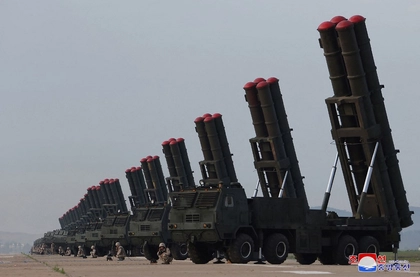Donald Trump sparked panic in European capitals for the umpteenth time earlier on Friday (20 December) when he repeated his threat to impose tariffs on EU exports to the US.
“I told the European Union that they must make up their tremendous deficit with the United States by the large scale purchase of our oil and gas,” the US president-elect wrote on his social media platform, Truth Social.
JOIN US ON TELEGRAM
Follow our coverage of the war on the @Kyivpost_official.
“Otherwise, it is TARIFFS all the way!!!” he added.
Trump is probably knocking on an open door. In recent weeks, both European Commission President Ursula von der Leyen and European Central Bank President Christine Lagarde have suggested that the EU should avoid a trade war with its largest trading partner by buying even more US liquefied natural gas (LNG).
There is little doubt that the EU’s rush to appease the self-styled “Tariff-Man” is at least partly based on legitimate fears about the potential damage his policies could do to the European economy.
As Trump has repeatedly pointed out, Europe exports significantly more to the US than the US exports to the EU – which intuitively means that an EU-US trade war would have an asymmetrically negative impact on Europe.
Indeed, much journalistic ink has been spilled in recent months about the potentially “apocalyptic” consequences of Trump’s trade policies on Europe’s ailing economy, which is already set to grow a third slower than the US over the next five years.

Davos Power Hour: Zelensky’s High-Stakes Talks for Ukraine
Analysts, however, mostly argue that Trump’s policies would likely not be catastrophic – although they would probably be bad.
In a presentation delivered in Brussels last week, Tom Orlik, chief economist at Bloomberg Economics, said that if Trump follows through on his promise to impose duties of 60% on Chinese goods and 20% on all other US imports, the total hit to the euro area GDP would be around 1%.
Such an impact would undoubtedly be significant. As Orlik noted, it would mean pushing the European economy, which is currently expected to grow by around 1% next year, “close to a recession”.
But it would hardly be earth-shattering. It would, for instance, pale in comparison to the 4.5% drop in annual GDP experienced during the European sovereign debt crisis in 2009.
“Even if Trump went full throttle, [with] maximal tariffs on Europe, there’d be a big blow, but probably not a catastrophic blow to European growth,” Orlik added.
Reasons for hope? Orlik suggested two reasons why Europe was likely to emerge from a Trumpian trade war bloodied but undefeated.
The first, he said, is that there are a host of other potential export markets for European goods.
“There are other trade relationships, other export destinations, other supply chain relationships, which European firms will be able to flex, [and] diversify their trade away from the United States,” he said.
The second, he noted, is that many of the goods that Europe sells to the US, such as German luxury cars, are relatively “inelastic” – meaning that demand is not significantly affected by price changes.
“It’s high-value stuff,” Orlik said. “It would be hard for the US to get it from anywhere else.”
However, other analysts have pushed back against the idea that it is even possible to accurately predict the impact of Trump’s trade policies on the European economy.
Carsten Brzeski, global head of macro at ING Research, said that several “mitigating factors” make any attempt to predict the consequences of Trump’s policies akin to “voodoo-nomics”.
In addition to the price inelasticity of EU exports to the US, Brzeski said that tariffs could have a beneficial short-term impact on EU trade by incentivising European companies to “front-load” their exports to avoid duties later in the year.
In addition, he suggested that Trump’s protectionist measures could lead to an inflationary resurgence in the US, thereby forcing the Federal Reserve to keep interest rates at an elevated rate – which in turn could cause the euro to depreciate against the dollar, thus making EU exports more competitive.
“It’s easy to see that with tariffs and with everything going on, the euro will weaken,” Brzeski explained. “And a weaker euro, we’ve all learned, is positive for European exports,” he added.
A new eurozone crisis?
But a tighter Fed policy arguably poses another potential risk for the eurozone: namely, that it could spill over into higher borrowing costs for heavily indebted eurozone countries such as France and Italy, thereby triggering a repeat of last decade’s eurozone crisis.
Orlik, however, downplayed such fears. He noted that the impact of Trump’s policies on EU borrowing costs would likely be in the order of a few decimal points, rather than the five to 10 percentage points seen during the sovereign debt crisis.
“Darkly hinting at the possibility of another European sovereign debt crisis is really good for business in the world of economics research,” he quipped.
“So it’s strongly in my interest to say [there will be another eurozone crisis], but my honest answer would be that this is a kind of marginal increase in borrowing costs,” he added.
“So, it’s a negative. It’s not a catastrophe.”
Reprinted from www.euractiv.com. You can read the original here.
You can also highlight the text and press Ctrl + Enter










